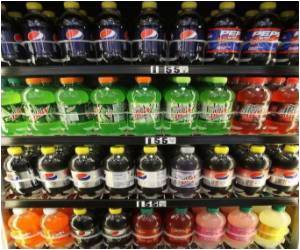Obese and diabetic people who consume high amounts of fructose are at risk for liver disease, says study.

Chronic fructose consumption in a diet puts people at risk for depleting their store of critically important molecules called ATP, which provide liver cells (and other body cells) energy for important cellular processes, including metabolism.
"The stores of liver ATP are decreased in obese and/or diabetic individuals who chronically consume increased amounts of fructose-containing beverages," said lead author Manal Abdelmalek, M.D., MPH, Associate Professor of Gastroenterology and Hepatology at Duke.
Nonalcoholic fatty liver disease is currently the leading cause of chronic liver disease in the United States. This condition can lead to elevated liver enzymes, inflammation and rarely even advanced scarring (cirrhosis) in individuals who do not drink alcohol.
In obesity and/or diabetes, the ability of the cells to optimally make ATP may already be impaired.
Unlike other simple sugars, fructose requires ATP for its metabolism. The inability to optimally generate cellular energy as well and the continued consumption of ATP from chronic fructose ingestion can result in the liver's depletion of energy. ATP depletion may increase risk for inflammation and scarring in the liver.
Advertisement
"Increased fructose consumption, and excess utilization of ATP favours the increase in molecules that lead to increased fatty acid synthesis as well as increased uric acid," he said.
Advertisement
The silver lining is that measuring the amount of uric acid in these individuals may help doctors predict the presence and monitor the severity of nonalcoholic fatty liver disease, Abdelmalek said.
Research by Abdelmalek published in the Journal of Hepatology in 2008 showed that, within a small subset of patients, fructose-containing beverages were associated with NAFLD compared to patients with comparable weight, age, and gender. Her 2010 research, published in Hepatology, went further and linked fructose with the liver injury and scarring (fibrosis).
The current study evaluated adults enrolled in the NIH-sponsored Look Ahead Fatty Liver Disease Ancillary Study headed by senior author Jeanne M.Clark, M.D., MPH, at Johns Hopkins University. The researchers analyzed dietary questionnaires collected in patients who underwent a magnetic resonance imaging to measure liver fat as well as an intravenous fructose challenge to evaluate the liver's ATP stores and response to ATP depletion.
Patients enrolled in the Look Ahead study had been counselled on lower dietary sugar consumption for the management of diabetes. Despite the overall lower levels of fructose use in this study population, the researchers found evidence of liver ATP depletion in those who consumed more fructose.
"The fact we found a difference in liver ATP stores at lower levels of dietary fructose intake does suggest that higher fructose consumption (as would occur with the consumption of processed food and sweetened beverages) could deplete the liver of energy and thus risk causing worse metabolic problems and potentially even liver injury," Abdelmalek said.
In the past 30 years, fructose consumption has more than doubled, according to Abdelmalek and authors.
The study has been published online at the Hepatology journal site.
Source-ANI















